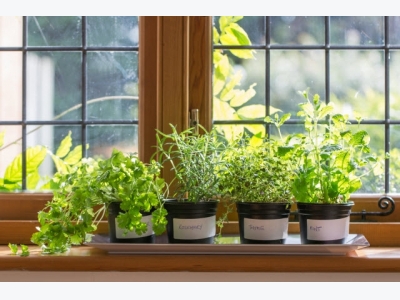How to Grow a Winter Kitchen Garden

Herbs growing on a windowsill. By CBCK / Shutterstock.com
Winter is a time of snowstorms, movie nights by the fire, and…fresh, homemade salsa? At least, it can be for those willing to give indoor vegetable gardening a shot. With a little gear and know-how, a wide variety of fresh produce can be successfully grown throughout the winter.
We spoke with Chad Knight, who teaches indoor gardening in Green Bay, Wisconsin—if they can grow in the winter up there, anyone can—to get his expert tips.
1. Choose Wisely
There are plenty of plants that can be grown indoors, including tomatoes, kale, radishes and more. Choose plants based on your taste and how much room you have to garden. Anyone with a spare windowsill can grow a few herbs. Those with more space can get creative. Maybe fill a bookshelf with rows of lettuce, or grow larger veggies in a tub beside your sofa. According to Knight, gardeners with a lot of space can go so far as turning a spare room into a greenhouse with a grow tent. But all you really need to get started are containers, soil, and a good lighting system to mimic the long growing days of summer.

Chili peppers growing on a windowsill. By Alina Kuptsova / Shutterstock.com
2. Contain Yourself
Herbs and leafy greens are good for beginners because they grow easily and have shallow roots, which means they can live in smaller containers. Lettuce, kale and spinach can be grown in pots or troughs, and many can yield for a prolonged period if only the outermost leaves are harvested.
If you want to grow deeper-rooting plants, such as carrots, you can save space if you buy a round variety such as Thumbelina, Atlas, or Parisian. Plants that get very bushy or leggy—like tomatoes or peppers—can be pruned, or miniature varieties can be selected. Keep in mind that tomatoes have to be staked in order to keep them upright and allow the fruit to ripen.
3. See the Light
Lighting is key to the success of your garden. No matter the season, a house is a dark habitat for produce. In northern winters, even window box gardens need a little extra light. According to Knight, herbs and leafy greens do fine with a few 50-watt grow light bulbs, but larger plants prefer high-intensity lighting systems, such as halide or high-pressure sodium bulbs. Such systems use more energy, but the light and heat they generate will help your plants flourish. These are typically placed in a light box designed to replicate the intense rays of full summer sun.

Be sure to tend to your indoor kitchen garden. By Natalia Bulatova / Shutterstock.com
4. Grow On
Perfecting your produce takes trial and error. Tend your garden like you would any other: Pay attention, remove dead or fallen leaves, consider fertilizing, and don’t overwater. Knight notes that indoor vegetables are particularly vulnerable to fungus, so he recommends using a fan to prevent condensation and to keep the air circulating, mimicking the breeze that blows over an outdoor garden. “Think about all the little cues that nature gives a plant,” Knight says. “You’re trying to bring the outdoors inside.”
Related news
 The benefits and history of aquaponics
The benefits and history of aquaponics Aquaponics is a combination of raising fish (aquaculture) and the soil-less growing of plants (hydroponics) that grows fish and plants together in one integrate
 How to grow tomatoes in a growing bag
How to grow tomatoes in a growing bag Find out how to grow tomatoes in a growing bag, indoors or outdoors, with the help of our step-by-step guide.
 Home Aquaponics Build
Home Aquaponics Build The build pictures you will see below are for an aquaponics system. Aquaponics is a method of growing vegetables (indoor or outdoor)